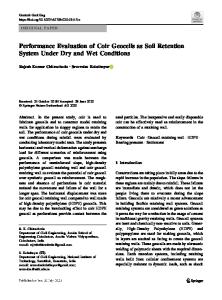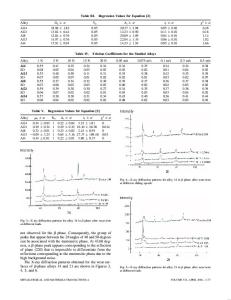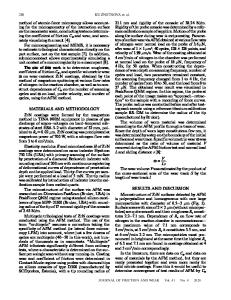Friction and Wear of Metals under Micro-abrasion, Wet and Dry Sliding Conditions
- PDF / 2,685,044 Bytes
- 11 Pages / 593.972 x 792 pts Page_size
- 29 Downloads / 340 Views
JMEPEG https://doi.org/10.1007/s11665-020-05102-3
Friction and Wear of Metals under Micro-abrasion, Wet and Dry Sliding Conditions Cesar David Resendiz-Calderon, Leonardo Israel Farfan-Cabrera , Joaquı´n Esteban Oseguera-Pen˜a, Irving Ca´zares-Ramı´rez, and Ezequiel Alberto Gallardo-Hernandez (Submitted April 17, 2020; in revised form August 4, 2020) This work aims to characterize and compare the coefficient of friction (CoF) and wear rates of some metallic materials (AISI 6061-T6 alloy, AISI 316 L stainless steel and ASTM F1537 CoCrMo alloy) under different wear modes, namely, micro-abrasion abrasion (rolling and mixed rolling/grooving abrasion), and wet and dry sliding abrasion. The wear modes were achieved by conducting testing under muddy environment at different SiC abrasive particles concentration and wet and dry conditions at three different loads (1, 2 and 3 N) using an instrumented micro-abrasion tester. Wear volumes were measured by optical profilometry to estimate wear rates, while wear patterns were visualized in detail by SEM. CoF, wear rate and mode results for all materials and conditions are reported and discussed. Wear modes were found to have a considerable effect on CoF and wear rate for the materials. Pure rolling abrasion generated the highest wear rates for all materials. Mixed rolling abrasion/grooving produced higher CoFs, but lower wear rates than those produced by pure rolling abrasion. Wet sliding promoted the highest CoFs for AISI 316L SS and AISI 6061-T6 meanwhile dry sliding generated the lowest CoFs and wear rates. Keywords
CoF, micro-abrasion, rolling abrasion, wear mode, wear rate
1. Introduction The micro-abrasion wear test is a suitable method used for characterization and evaluation of wear rate and resistance of a wide range of materials, namely, metals (Ref 1-3), ceramics (Ref 4-7), polymers (Ref 8, 9) and thin coatings (Ref 10-12) under rolling abrasion mechanism. The method basis is to produce a wear crater with defined geometry, commonly spherical or ellipsoid cap, on a small and thin flat specimen by loading it against a rotary hard ball, usually with 25.4 mm in diameter, in presence of an abrasive slurry made of deionized water and hard abrasive particles (4-8 lm) (Ref 13, 14). The advantage of this test is the formation of defined small wear scars (micro-scale) with rolling abrasion patterns and, in some cases, plowing or grooving features depending on some testing conditions (Ref 15-17). Both are variants from micro-abrasive wear depending on the dynamics of the abrasive particles which can involve rolling of the particles at the interface (rolling abrasion) or sliding of the abrasive particles at the interface (grooving or plowing) (Ref 15, 18-20). Rolling abrasion is produced by free hard micro-particles rolling at the sliding interface promoting commonly numerous micro-indentations
Cesar David Resendiz-Calderon, Leonardo Israel Farfan-Cabrera, Joaquı´n Esteban Oseguera-Pen˜a, and Irving Ca´zares-Ramı´rez, Tecnologico de Monterrey, Escuela de Ingenierı´a y Ciencias, Ave
Data Loading...











